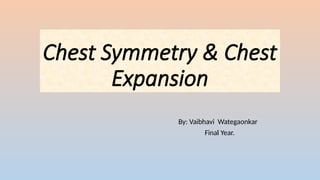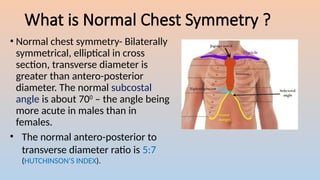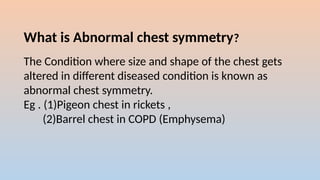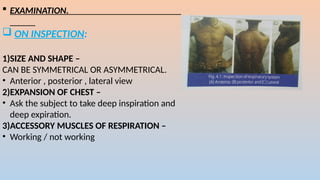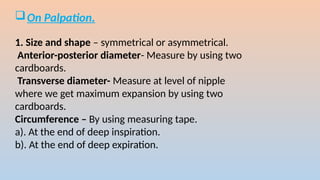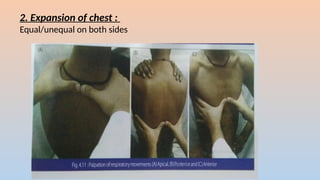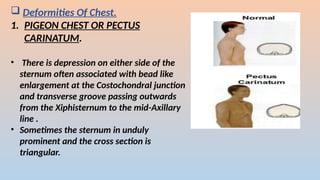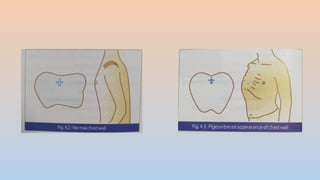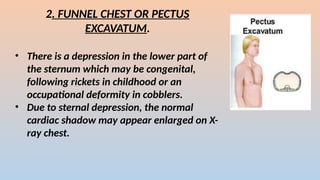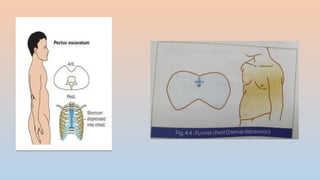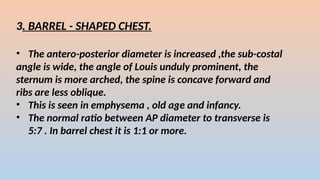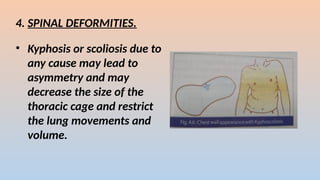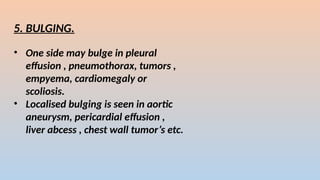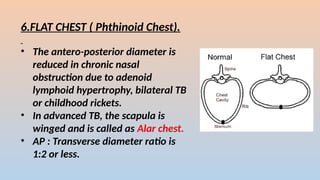Chest Symmetry & Chest Expansion-1.pptx.
- 1. Chest Symmetry & Chest Expansion By: Vaibhavi Wategaonkar Final Year.
- 2. What is Normal Chest Symmetry ? ? Normal chest symmetry- Bilaterally symmetrical, elliptical in cross section, transverse diameter is greater than antero-posterior diameter. The normal subcostal angle is about 700 ¨C the angle being more acute in males than in females. ? The normal antero-posterior to transverse diameter ratio is 5:7 (HUTCHINSON¡¯S INDEX).
- 3. What is Abnormal chest symmetry? The Condition where size and shape of the chest gets altered in different diseased condition is known as abnormal chest symmetry. Eg . (1)Pigeon chest in rickets , (2)Barrel chest in COPD (Emphysema)
- 4. ? EXAMINATION. ? ON INSPECTION: 1)SIZE AND SHAPE ¨C CAN BE SYMMETRICAL OR ASYMMETRICAL. ? Anterior , posterior , lateral view 2)EXPANSION OF CHEST ¨C ? Ask the subject to take deep inspiration and deep expiration. 3)ACCESSORY MUSCLES OF RESPIRATION ¨C ? Working / not working
- 5. ?On Palpation. 1. Size and shape ¨C symmetrical or asymmetrical. Anterior-posterior diameter- Measure by using two cardboards. Transverse diameter- Measure at level of nipple where we get maximum expansion by using two cardboards. Circumference ¨C By using measuring tape. a). At the end of deep inspiration. b). At the end of deep expiration.
- 6. 2. Expansion of chest : Equal/unequal on both sides
- 7. ? Deformities Of Chest. 1. PIGEON CHEST OR PECTUS CARINATUM. ? There is depression on either side of the sternum often associated with bead like enlargement at the Costochondral junction and transverse groove passing outwards from the Xiphisternum to the mid-Axillary line . ? Sometimes the sternum in unduly prominent and the cross section is triangular.
- 9. 2. FUNNEL CHEST OR PECTUS EXCAVATUM. ? There is a depression in the lower part of the sternum which may be congenital, following rickets in childhood or an occupational deformity in cobblers. ? Due to sternal depression, the normal cardiac shadow may appear enlarged on X- ray chest.
- 11. 3. BARREL - SHAPED CHEST. ? The antero-posterior diameter is increased ,the sub-costal angle is wide, the angle of Louis unduly prominent, the sternum is more arched, the spine is concave forward and ribs are less oblique. ? This is seen in emphysema , old age and infancy. ? The normal ratio between AP diameter to transverse is 5:7 . In barrel chest it is 1:1 or more.
- 13. 4. SPINAL DEFORMITIES. ? Kyphosis or scoliosis due to any cause may lead to asymmetry and may decrease the size of the thoracic cage and restrict the lung movements and volume.
- 14. 5. BULGING. ? One side may bulge in pleural effusion , pneumothorax, tumors , empyema, cardiomegaly or scoliosis. ? Localised bulging is seen in aortic aneurysm, pericardial effusion , liver abcess , chest wall tumor¡¯s etc.
- 15. 6.FLAT CHEST ( Phthinoid Chest). ? The antero-posterior diameter is reduced in chronic nasal obstruction due to adenoid lymphoid hypertrophy, bilateral TB or childhood rickets. ? In advanced TB, the scapula is winged and is called as Alar chest. ? AP : Transverse diameter ratio is 1:2 or less.
- 16. Thank you!!
